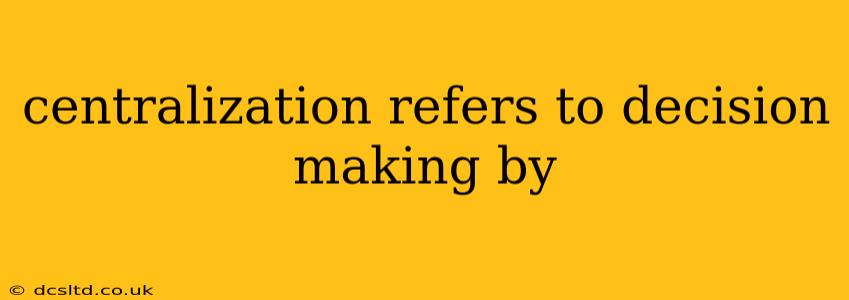Centralization, in the context of organizational structure and management, refers to the concentration of decision-making authority at a high level within an organization. Instead of numerous individuals or teams making independent choices, a smaller group at the top—typically senior management—holds the power to dictate policy, strategy, and operational procedures. This contrasts sharply with decentralization, where decision-making authority is distributed among various levels and departments. Understanding the nuances of centralization is crucial for effective organizational management.
What are the Advantages of Centralization?
Centralized decision-making offers several key advantages:
- Consistency and Uniformity: A centralized structure ensures consistent application of policies and procedures across the entire organization. This leads to a unified brand image, streamlined operations, and reduced confusion.
- Efficiency and Speed: In certain situations, centralized decision-making can be faster and more efficient. When faced with urgent matters, a single point of authority can make quick decisions without extensive consultation.
- Clear Accountability: With centralized decision-making, responsibility for outcomes rests clearly with the top leadership. This simplifies accountability and allows for easier performance evaluation.
- Economies of Scale: Centralized purchasing, resource allocation, and other functions can lead to significant cost savings through bulk discounts and optimized resource utilization.
- Stronger Brand Identity: A centralized approach to marketing and branding ensures a consistent message and image, enhancing brand recognition and customer loyalty.
What are the Disadvantages of Centralization?
While offering benefits, centralized decision-making also carries potential drawbacks:
- Bureaucracy and Slow Response: The hierarchical nature of centralized organizations can lead to bureaucratic delays as decisions filter through multiple layers of management. This can hinder responsiveness to changing market conditions or customer needs.
- Lack of Employee Empowerment: Centralized systems can stifle employee initiative and creativity as individuals lack autonomy in decision-making. This can lead to low morale and reduced productivity.
- Bottlenecks and Inefficiencies: Over-reliance on top management for all decisions can create bottlenecks, slowing down progress and hindering operational flexibility.
- Reduced Adaptability: In dynamic environments, centralized organizations may struggle to adapt quickly to changes because decisions need to be approved by higher authorities.
- Risk of Misinformation: Concentrating information flow at the top can lead to a lack of information at lower levels, potentially causing misunderstandings and inaccurate decision-making.
Who Makes Decisions in a Centralized Organization?
The primary decision-makers in a centralized organization are typically:
- Top-level management: This includes the CEO, executives, and senior managers who set overall strategy and direction.
- Specialized departments: In some cases, specific departments (like finance or legal) might have centralized authority within their areas of expertise.
- Board of Directors: For publicly traded companies, the board of directors often plays a significant role in major strategic decisions.
How Does Centralization Differ from Decentralization?
Centralization and decentralization represent opposite ends of a spectrum in organizational structure. Decentralization distributes decision-making authority across different levels and departments, empowering employees and promoting flexibility. The choice between centralization and decentralization depends on various factors, including the organization's size, industry, culture, and strategic goals.
What Factors Influence the Degree of Centralization?
Several factors influence the degree to which an organization adopts a centralized structure:
- Organizational size: Larger organizations often require a more centralized structure to maintain control and coordination.
- Industry: Industries with high levels of regulation or standardization may favor centralization.
- Organizational culture: Organizations with hierarchical cultures often prefer a centralized approach.
- Technology: Advanced communication and information technology can facilitate decentralization.
- External environment: Rapidly changing external environments may necessitate a more decentralized structure for increased responsiveness.
In conclusion, the degree of centralization is a strategic choice that significantly impacts organizational effectiveness. Understanding the advantages and disadvantages of both centralized and decentralized structures is crucial for organizations to design effective management systems that optimize performance and adapt to changing environments.
